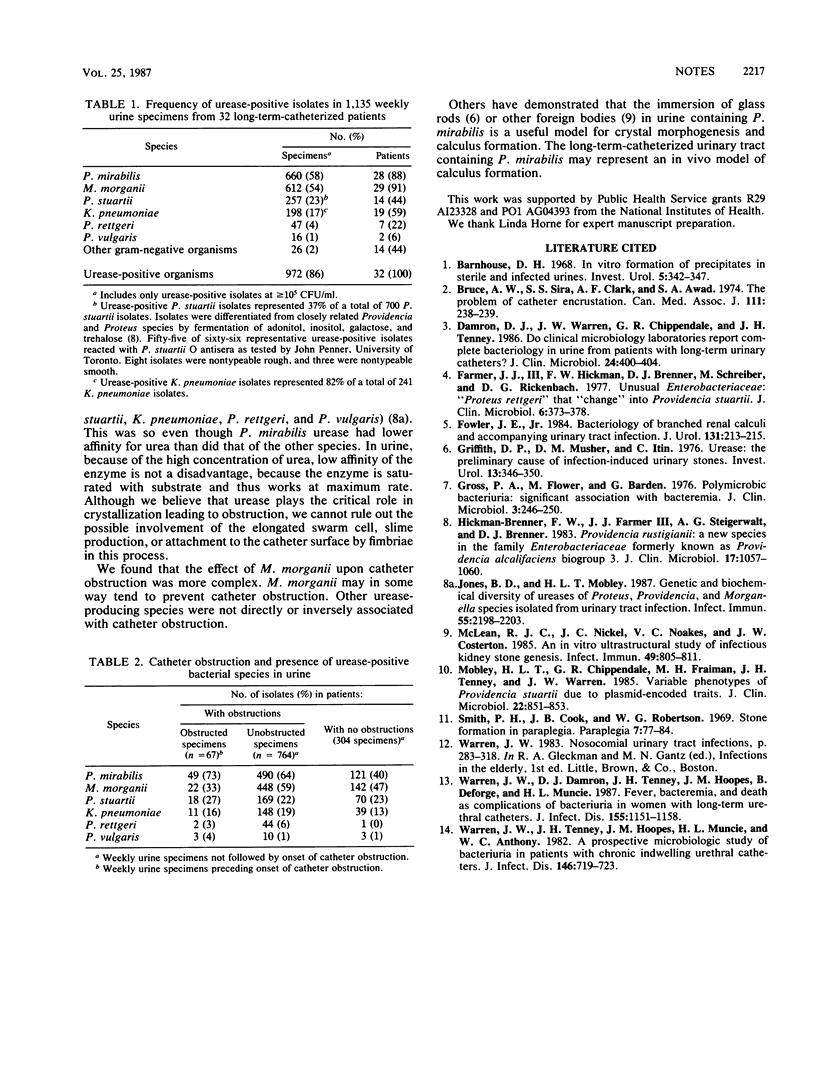Abstract
Long-term urethral catheterization (greater than or equal to 30 days), a management technique for urinary incontinence, results in polymicrobial bacteriuria. We frequently found urease-producing bacteria: of 1,135 weekly urine specimens from 32 long-term-catheterized patients, 86% had urease-positive bacterial species at greater than or equal to 10(5) CFU/ml. The most common species were Proteus mirabilis and Morganella morganii, each found in over half the specimens. P. mirabilis, but not other urease-positive species, was significantly associated with the 67 obstructions observed in 23 patients. M. morganii had a more complex association and in some way may protect the catheter from obstruction.
Full text
PDF

Selected References
These references are in PubMed. This may not be the complete list of references from this article.
- Bruce A. W., Sira S. S., Clark A. F., Awad S. A. The problem of catheter encrustation. Can Med Assoc J. 1974 Aug 3;111(3):238–passim. [PMC free article] [PubMed] [Google Scholar]
- Damron D. J., Warren J. W., Chippendale G. R., Tenney J. H. Do clinical microbiology laboratories report complete bacteriology in urine from patients with long-term urinary catheters? J Clin Microbiol. 1986 Sep;24(3):400–404. doi: 10.1128/jcm.24.3.400-404.1986. [DOI] [PMC free article] [PubMed] [Google Scholar]
- Farmer J. J., 3rd, Hickman F. W., Brenner D. J., Schreiber M., Rickenbach D. G. Unusual Enterobacteriaceae. "Proteus rettgeri" that "change" into Providencia stuartii. J Clin Microbiol. 1977 Oct;6(4):373–378. doi: 10.1128/jcm.6.4.373-378.1977. [DOI] [PMC free article] [PubMed] [Google Scholar]
- Fowler J. E., Jr Bacteriology of branched renal calculi and accompanying urinary tract infection. J Urol. 1984 Feb;131(2):213–215. doi: 10.1016/s0022-5347(17)50311-0. [DOI] [PubMed] [Google Scholar]
- Griffith D. P., Musher D. M., Itin C. Urease. The primary cause of infection-induced urinary stones. Invest Urol. 1976 Mar;13(5):346–350. [PubMed] [Google Scholar]
- Gross P. A., Flower M., Barden G. Polymicrobic bacteriuria: significant association with bacteremia. J Clin Microbiol. 1976 Mar;3(3):246–250. doi: 10.1128/jcm.3.3.246-250.1976. [DOI] [PMC free article] [PubMed] [Google Scholar]
- Hickman-Brenner F. W., Farmer J. J., 3rd, Steigerwalt A. G., Brenner D. J. Providencia rustigianii: a new species in the family Enterobacteriaceae formerly known as Providencia alcalifaciens biogroup 3. J Clin Microbiol. 1983 Jun;17(6):1057–1060. doi: 10.1128/jcm.17.6.1057-1060.1983. [DOI] [PMC free article] [PubMed] [Google Scholar]
- Jones B. D., Mobley H. L. Genetic and biochemical diversity of ureases of Proteus, Providencia, and Morganella species isolated from urinary tract infection. Infect Immun. 1987 Sep;55(9):2198–2203. doi: 10.1128/iai.55.9.2198-2203.1987. [DOI] [PMC free article] [PubMed] [Google Scholar]
- McLean R. J., Nickel J. C., Noakes V. C., Costerton J. W. An in vitro ultrastructural study of infectious kidney stone genesis. Infect Immun. 1985 Sep;49(3):805–811. doi: 10.1128/iai.49.3.805-811.1985. [DOI] [PMC free article] [PubMed] [Google Scholar]
- Mobley H. L., Chippendale G. R., Fraiman M. H., Tenney J. H., Warren J. W. Variable phenotypes of Providencia stuartii due to plasmid-encoded traits. J Clin Microbiol. 1985 Nov;22(5):851–853. doi: 10.1128/jcm.22.5.851-853.1985. [DOI] [PMC free article] [PubMed] [Google Scholar]
- Smith P. H., Cook J. B., Robertson W. G. Stone formation in paraplegia. Paraplegia. 1969 Aug;7(2):77–85. doi: 10.1038/sc.1969.15. [DOI] [PubMed] [Google Scholar]
- Warren J. W., Damron D., Tenney J. H., Hoopes J. M., Deforge B., Muncie H. L., Jr Fever, bacteremia, and death as complications of bacteriuria in women with long-term urethral catheters. J Infect Dis. 1987 Jun;155(6):1151–1158. doi: 10.1093/infdis/155.6.1151. [DOI] [PubMed] [Google Scholar]
- Warren J. W., Tenney J. H., Hoopes J. M., Muncie H. L., Anthony W. C. A prospective microbiologic study of bacteriuria in patients with chronic indwelling urethral catheters. J Infect Dis. 1982 Dec;146(6):719–723. doi: 10.1093/infdis/146.6.719. [DOI] [PubMed] [Google Scholar]


